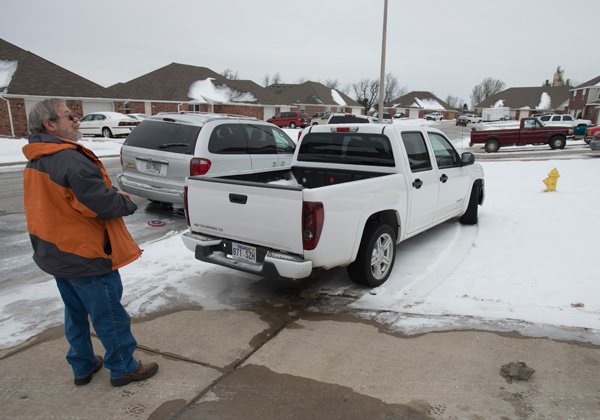SPRINGDALE — An often-maligned city division could get a new home officials believe will improve workers’ efficiency.
The City Council is to vote Tuesday on moving the Code Enforcement Division from the Buildings Department to the Public Works Department. The council’s Finance Committee voted this week to place the change on the agenda for the 6 p.m. meeting.
By The Numbers
Budget Changes
Creating a Community Engagement Division will affect Springdale's budget.
• Increase for new division: $327,905
• Decrease in Buildings and Street Division: $275,395
• Total Increase in budget: $52,510
• Costs for full entire year: $100,000
Source: City Of Springdale
“I’m glad they are doing something,” said Rick Culver, a resident who lost a special election for council last year. “I heard more complaints about code enforcement than anything else.”
Code enforcement officers look for violations that aren't criminal offenses, said Mike Chamlee, director of the Buildings Department. Those infractions usually are visible, including piles of junk and trash, tall grass and weeds, and improper parking.
Code enforcement could benefit from a fresh start, said Mayor Doug Sprouse.
“After I looked at it, from an enforcement capacity and organization standpoint, it looks to be a better fit than (in) Buildings,” Sprouse said.
Efficiency can be increased by using more technology, and a larger department with more employees puts more eyes on the street, Sprouse said.
How effectively code enforcement officers perform their jobs can have a major impact on the property value and community image, according to the American Association of Code Enforcement website. Code enforcement officers support and enhance quality of life, while working to keep aging buildings, homes and properties from becoming eyesores, according to the website.
Code enforcement would become part of a Community Engagement Division of Public Works along with the bulky waste, graffiti abatement and drop-off recycling programs, said Sam Goade, director of the Public Works Department. The idea for the reorganization came after interaction between code enforcement and bulky waste workers, he said.
When complaints were sent to code enforcement about trash in yards, those employees checked with bulky waste staff members to see if residents had put out the material for pickup, Goade said.
“The more I talked to code people, the more I realized that we could work together better,” Goade said.
Code enforcement was once a division in the Planning Department, said Mike Chamlee, buildings director. Code enforcement was a part of the Police Department initially, went to the Fire Department for a short time and then was moved to Planning, said Kevin McDonald, assistant fire chief.
Oversight of code enforcement varies from city to city. In Rogers, code enforcement is under the Code Management Department, said James Willett, director. The department includes building inspections and animal services.
Code enforcement crosses department boundaries, he said. When there's a violation of an ordinance, Rogers code enforcement officers work with the department that oversees that area.
“We are the enforcement arm,” he said.
In Bentonville, code enforcement is part of the Community Development Department, said Troy Galloway, department director. The department includes engineering, planning and building inspections.
“A lot of what we see is property maintenance and zoning violations,” Galloway said. “That falls right into our wheelhouse.”
In Fayetteville, code enforcement is part of the Development Services Department. It’s in the Community Services Division along with the Community Development Block Grant program and animal services, said Yolanda Fields, division director. Code enforcement has been part of the division since 2002, she said.
Code enforcement officers regularly interact with various departments, such as fire, police, building, planning and legal as well as a city’s legislative body, its boards and commission members, according to the Code Enforcement Association website.
Springdale’s reorganization would move a position to building inspections, Sprouse said. Danny Snow, code supervisor, would become a building project specialist.
Missha Wagoner, who supervises bulky waste, graffiti removal and recycling, would become the Community Engagement Division supervisor, Goade said.
The cost of the change would be less than $100,000 annually, Sprouse said. The costs include raises for increased duties, new equipment and new services, such as more phone lines, said Wyman Morgan, city director of administration and financial services.
If the change is approved, code enforcement officers will be equipped with iPads to allow better communication, Wagoner said. The bulky waste truck, snow plows and spreaders are already equipped with the tablet computers, Goade said.
The computers will allow the closest officer to respond to a problem, Wagoner said.
All of the public works employees will be able to report a problem to code enforcement, Goade said.
“We’ve got 48 additional employees that see a lot of the city and, once engaged, can report problems,” Goade said.
The Public Works Landscaping Division can mow property where grass grows too tall, Goade said, and the bulky waste truck can pick up trash that has piled up.
“Buildings doesn’t have the resources that we have at public works,” he said.
The Community Engagement Division would be based in the former Criminal Investigation Division building at 206 N. Blair St., Goade said. The police division moved to a renovated building near the City Administration Building on Shiloh Square.
Education will be a big part of the division’s mission, Wagoner said. People need to know that graffiti and unsafe or unsanitary conditions are not good for them and the whole community, she said.
“I want to meet with people to let them know why we have codes, and what is expected of them,” Wagoner said. “We can help them buy into the community.” “Everyone wants to live in a safe, clean, respectable community.”
Culver said he will be watching to see how the change affects the city.
“I’m curious to see if it will work,” he said. “I hope it does. I hope it works great.”

